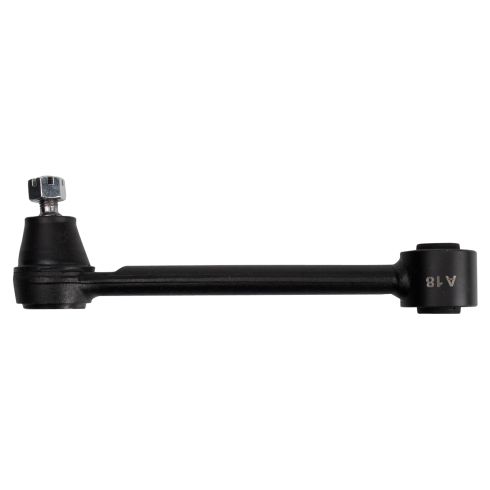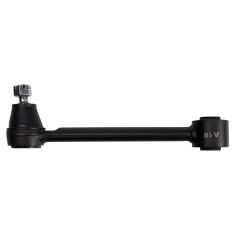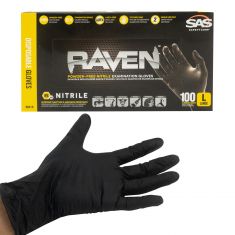Hey friends, it's Len here at 1AAuto. Today I'm going to be showing you a fun job. We're going to be doing a rear lower lateral link. Try saying that three times fast. It should be fairly easy. I want to be the guy that shows you how to do it. If you need this, or any other part, you can always check us out at 1AAuto.com.
Now it's time to loosen these up okay. 21 millimeter ... we've got our long ratchet here. I've got the majority of the weight of the vehicle off the ground, it's just barely touching, so I can remove the lug nuts or at least break them free without spinning the wheel. Okay. Just going to give it a quick crank, not going to loosen it up all the way. Last lug nut, I'm holding the wheel. Take off our hubcap and we're going to carefully take the wheel down and lower it to the ground, and we'll put it safely out of the way.
So right here is where your rear lower lateral link starts, mounts into the sub frame, comes through this arm right here and goes into the knuckle. Okay. Right back here is where the nut is. It's going to be kind of a good luck situation getting that out unless of course you do something which is very simple: remove the shock. The lower end of the shock is a 19 and a 19, and then up here 14, 14. Take this out, get it aside. We'll be able to get to that nut easy peasy. Let's do that.
So here we go. We're going to take out the lower area of this shock first. This side right here is a 19. I'm going to use a wrench. I'm just going to get it on there. The other side also a 19. You can use a ratchet. You can use whatever you want, we're just going to get it off. I'm going to use an air gun. Give this a little shake. It feels like it's pretty much ready to come out. There's my bolt. 14, 14 ... whatever you got to do to take them out. You do you boo boo. And here we go. Let's grab both of these. That's what they look like. They're both the same. Grab my shock, I'm going to condense it, pull it up and out.
So I just want to let you know that I'm going to be replacing this rear shock. So if you happen to notice that one magically appears, it's brand new, lucky you, lucky me, whatever. I'm doing another video so it's going to be new by the time it goes back in. So if you happen to see old magically new, well that's the reason why. Okay. Let's set this aside. We'll get back to work.
So right up here we have our 17 millimeter nut, then we have a bolt that comes through from the front to the rear, and it comes to right here, with a 19 millimeter head. So 19, 17. I'm going to hold the 19 with my wrench. I'm going to use my air gun with an extension and a swivel socket, safety glasses on, hand protection. There we are. Let's check to see if it's warm. It is a little warm. A lot of times this adjustment bolt freezes up inside the bushing that's in the middle right here, super common, so you're just going to have to do a little bit of figuring out of what you're going to do in your particular case. Maybe yours will pop right out. Mine is not, so what I'm going to do, I'm going to heat this end up. I'm going to get it nice and hot. I'm going to come over here with my spray. I'm going to spray here and have the heat pull my penetrant through the bushing, and hopefully it'll free it up. I'm going to let it sit like that for a little while once I get that all going, and I'll go ahead and work on this side.
Let's get this sparked up. Flame on. Some flamage going. All I'm doing now is, like I said before, I'm going to heat up this end of the bolt then I'm going to spray the other end with penetrant, and the heat will draw the penetrant through that bushing. The penetrant will do its job and I'll be able to get this bolt out. Of course I'm going to think about is any time you heat metal you're also weakening it, so there's always that to think about as well. So if you just go ahead and heat it and then cool it, and then heat it and then cool it, it might cause issues down the line, weakening your bolt. If you use a torch, something like this, that likes to move around, just keep them moving 'til we see a little bit of smoke coming up. That's when we know things are getting warm. Looks like it's pretty darn hot to me.
I have my penetrant. Just going to leave that in there. Okay, let's let that do its job. So now it's time to get that bolt out of there. We know it's stuck in the bushing on this arm. What I'm going to do is I'm going to take my nut, I'm going to put it back on the threads so it's pretty much flush, and I'm going to do what I have to do to try to drive this bolt out. For me personally I have access to an air hammer. So I'm going to level this out. I'm going to use a 17 millimeter socket because that's the size of the nut that I took off. I've got this special tool right here, slides my half inch socket right on there. This is an impact socket. It's not the chrome ones obviously which will shatter. Safety glasses, hand protection ... just going to give it a couple blasts here and see if I can get it to move.
Mm-hmm, looks like it's starting to move. Give it a couple sprays here. Let's blast it again.
I'm going to loosen up that nut a little bit and we'll keep on keeping on. I'm just going to keep on trying to drive this bolt out. I don't want to go too much with taking off the nut because I need to make sure I have at least few good threads in there. Less threads you have the less grip you're going to have, and the more chances you're going to strip it right out. And it's always a good habit to new bolts for up here, the adjustment bolts. Looks like it's coming out even more, cool. All right. Let's keep going with this nut. There's a washer under there, so what I'm going to do is I'm going to take the nut back off. I'm going to try to get that washer out of there. Maybe that'll give us a little bit more throw here. Try to get this bolt out a little further.
I'm assuming once we get it to a certain point the bolt should just want to come free on its own. Washer ... I'm doing everything I can to try not to damage these threads, super important if you're planning on reusing the bolt. If you're not, well, you do you boo boo.
Get this nut back off a here. So the bolt is coming out it's just taking its sweet time. I'm going to get this little cam off a here. So now it's time to get this bolt out. It's been causing us a little bit of havoc here, a little bit of problems. At this point it really just doesn't want to come out so I'm going to have to do it forcibly. We don't have another one of these bolts on hand. We've got one on order. It's going to be coming in in a couple days here, so all I'm going to do is I'm going to put in a regular bolt as a temporary fix. This vehicle's not going to be driven down the road until we get the correct part. So I just want to specify that.
So here we go, hammer time. Let's get this bolt right out of here. There it is. Right along here is where it sits inside that bushing and where it was causing all of the problems. So on the other end of that we have a little cotter pin here. You can try to get it out if you want, use some cutters or whatever you want to do, or you can just ... if you have an extra one of course, just go ahead and break it right off. That's good enough. I'm going to put my 17 millimeter on there. There we are. Throw on an extension on my half inch air gun. You can try using a ratchet or a wrench, or whatever you want to do. It's a 17 millimeter. Eye protection, hand protection ... here we are.
Now I'm going to grab my pickle fork. So now I'm going to go ahead and take this side out. Right, I'm going to use my hammer and my pickle fork, it looks something like this, and see if I can't figure out a way to get it in here. There we are. That's separated. I'm going to grab a pry bar. I'm going to pop this end down so it's going to fall down. Make sure that we watch our face of course. If I grabbed it a little bit longer of a pry bar it might have been nice. Let's see ... here we go. Okay. That came apart. That's where the stud is supposed to be. We'll get the other end right here and it's still inside the knuckle, so I'm just going to knock it out real quick.
Here we are. That ball right there is supposed to sit inside this socket. As you can tell it was very bad. It came right apart easy peasy, so good thing we replaced that.
Okay. So I got a bolt. It's nothing special. I know it's not the right one. I don't recommend putting in the wrong bolt and driving it down the road. Like is said this one is going nowhere. This is just a temporary fix so I can show you how to get it done and get it off my lift. So here we go. I'm going to get this in here. Now with this end I'm going to try to ... I pushed it so it's at an angle like that and I'll show you why, because when you try to get it into the slot in the knuckle the angle really helps. I'm going to use my hammer. I'll bonk this up in here. There we are. Looks pretty good.
Okay, so I got my new old bolt, or old new bolt. I'm just going to put it through. Here we are. I'm going to grab my washer and my nut, get those on there, and I can tell you what size these are but in all honesty it really doesn't matter to you so much. You would want to go with the original sizes okay. So I'm going to go ahead and snug those up, get my nut on over here. Okay, for me, I'm going to be using a 14 on the back and a 17. For you, you're going to be using your 19 and your 17. I'm going to see if I can get these on here. If you have access to an air gun it's going to cut your time in half. I want to make sure this is nice and tight. Get it aligned. We're going to have the right bolt in there and everything. So there's that.
Now we're going to do this side. We got a brand new nut and a brand new cotter pin, super nice of 1A Auto. Here we are. 17, feels like it might be getting close ... yeah, here we go, finally. Okay. I feel like it bottomed out. I'm just going to give it a little more. Now I'm going to check it. I want to see if the slot on the nut matches up with the hole on the stud. Looks like it's pretty darn close, maybe just a little tug. There we are. Now I'm going to grab my cotter pin, brand new, I'm just going to pull it out of the bag here. Okay, I just put it through, now I'm going to bend it up. You want to be careful if you're using your hands, you don't want to cut yourself, but all it really has to do is just be bent so it can't fall out. There we are, that feels pretty great, tight.
We've got our brand new quality 1A Auto shock here. What I'm going to do at this point, I'm just going to compress it, okay. I'm going to put it up in here. There we are, perfect. So we got it hanging out. It's doing it's thing. It's having a good time with it's buddies. I'm going to line up the bottom bolt hole. I'm just going to wiggle the shock around so this bolt can go all the way through. Here we are. Start the nut on. Like I said, thread lock her if you want, it's up to you. It's your prerogative. We have our two upper bolts. Now that we have the lower bolt through now is a great time to do the upper. Go ahead and do this, and we can just flex it a little bit. I'm going to get this over to where it needs to go.
I'm just going to start the one that does reach. There we are. Cool. You can take a jack or whatever you've got, try to jack this up. I'm just going to use something as basic as a pry bar. All I need it to do is come up enough to get my bolt started. Once I get it started I'll just go ahead and tighten them down and it'll pull it right in, no worries, easy peasy. We're going to tighten these up, 14 millimeter. Jump over to this one and then I'll tighten that one up fully. Both of them are pretty good so we'll go ahead and tighten it. Feels good. I'll just get this one again real quick. Very nice: tight, tight. As you can see the rubber seal along the top that I was talking about is pressed right up against the body of the vehicle. We won't get any moisture in there. So now we can move ahead.
We're going to go down to our lower bolt. That's going to be torqued to 116 foot pounds. Let's grab our tools. To get these started, or bottom them out, we're going to go 19 19 okay, and then we'll go ahead and torque them down once it's fully bottomed out. There we are, 116 foot pounds with my 19 millimeter.
All right, it's time to get the wheel up on here. We've got our lug nuts close. We've got our hubcap. I'm just going to take it, roll it up my leg here, get it on there. Take my hubcap, we've got our little slot right there where our valve stem goes through, get one lug nut on while I'm still holding it, make sure it's on there good. There we go, the wheel can't fall off. Now I'm going to grab the others. 21 millimeter ... I'm just going to bottom these out. You can use an air gun if you have access to it. All right. I want to make sure that we do this in the star pattern, so the wheel won't get kinked on like this. If I tighten this one up and then this one, the wheel might be sitting like this. I might think I have these tightened down when really they're not right, I mean pretty obvious.
So we'll get it close, we'll come down here, air gun will make short work of this. Time to torque this down: 21 millimeter, star pattern. I'm going to go 80 foot pounds. Let's go ahead and go around in a circle here now.
Thanks for watching. Visit 1AAuto.com for quality auto parts shipped to your door, the place for DIY auto repair. And if you enjoy this video please click the subscribe button.













